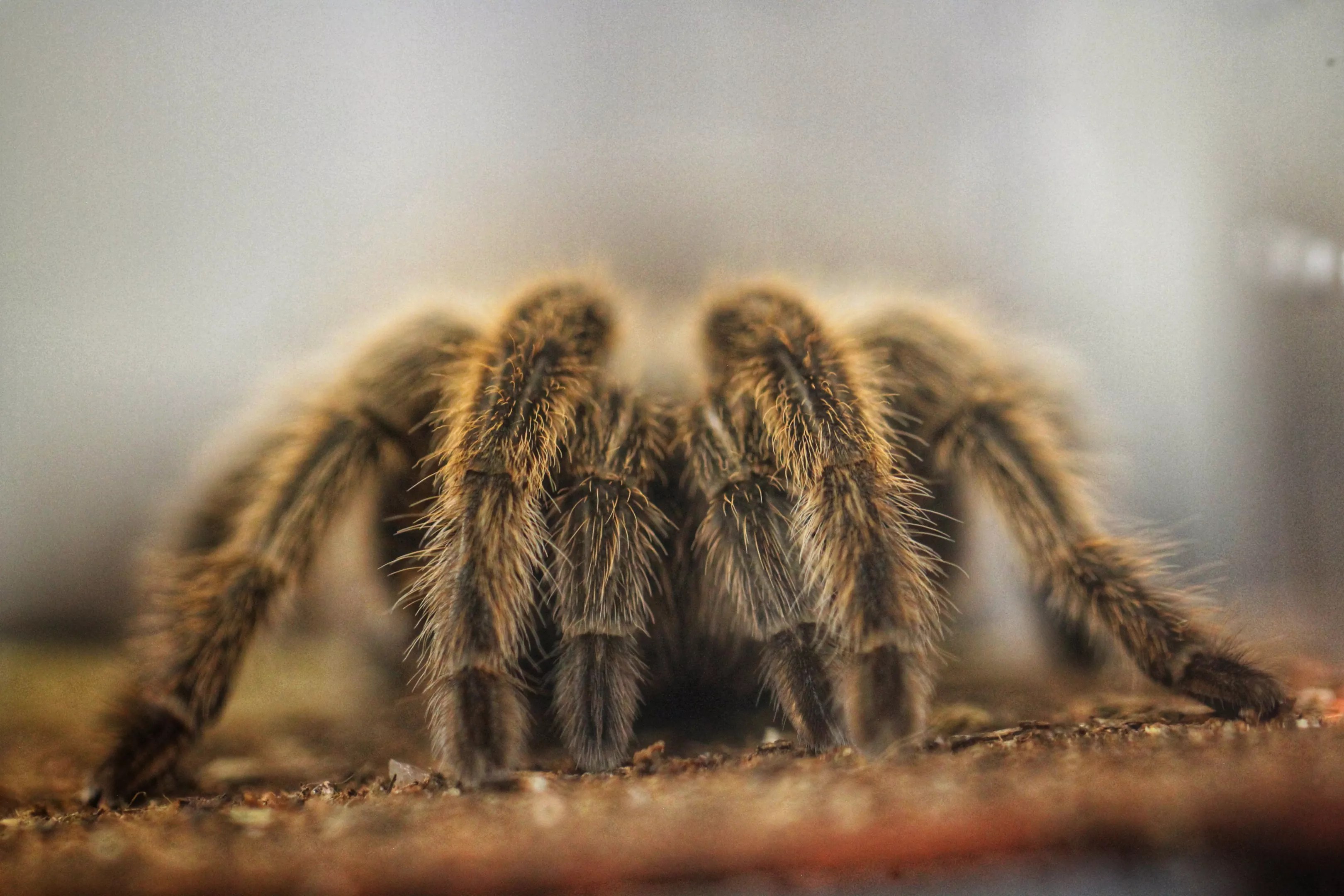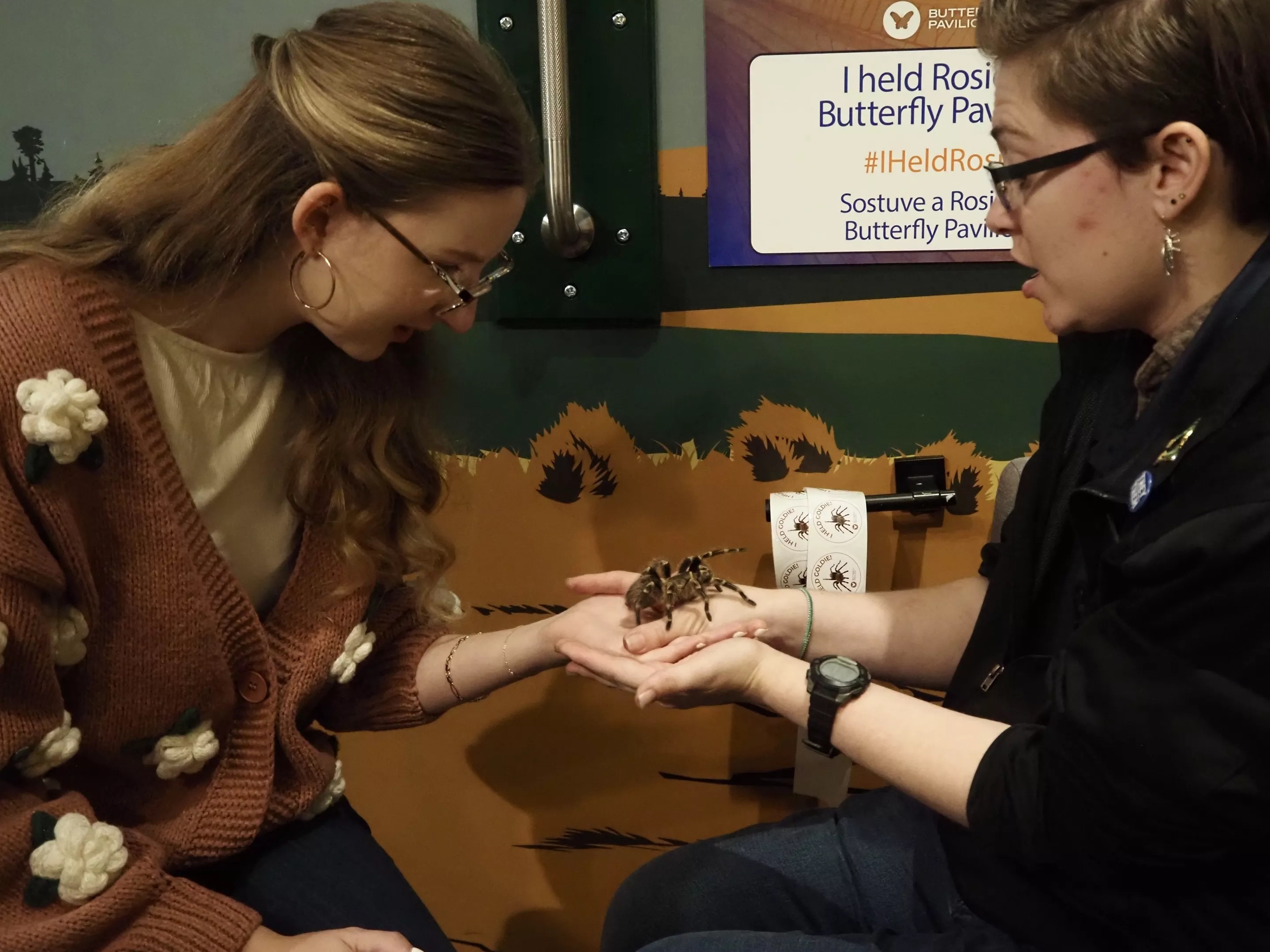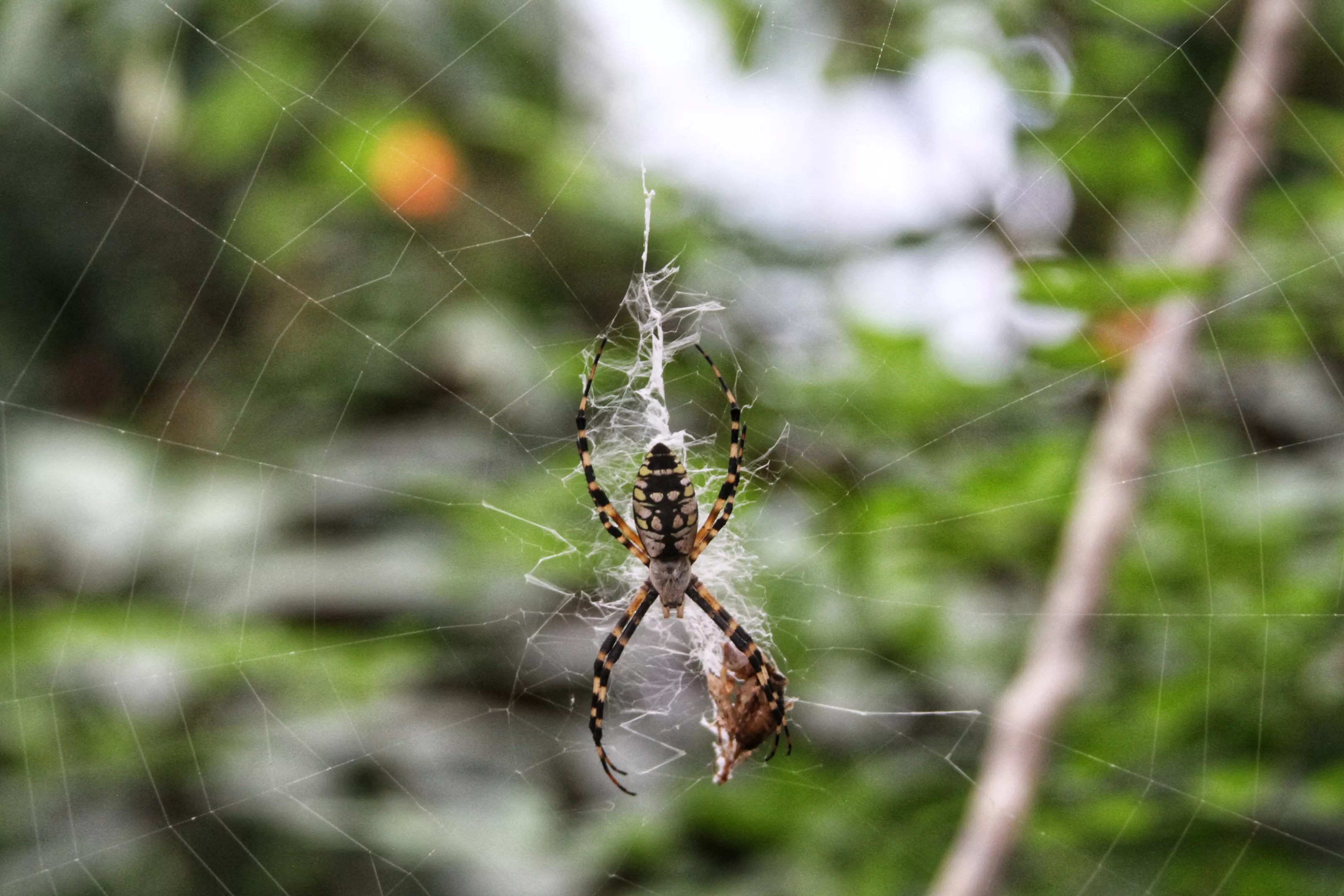
Butterfly Pavilion

Audio By Carbonatix
Over three decades, Rosie crawled into thousands of palms, her eight hairy legs unexpectedly soft and her demeanor surprisingly gentle for a spider larger than a child’s hands. Over the years, holding Rosie the Chilean rose hair tarantula became almost synonymous with visits to the Butterfly Pavilion in Westminster during birthdays, field trips or just for fun.
But now Rosie is tired and ready to dust off the guitar she gave up years ago, join a book club, play some mahjong and retire. The Butterfly Pavilion announced in August that beginning September 8, Rosie would transition from a public handling experience to a dedicated exhibit home, where visitors will be able to see her but no longer hold her.
Those who are brave enough to get up close and personal (or invertebral?) with bugs will still have the opportunity to do so through new programming and the Butterfly Pavilion’s upcoming Spiders Around the World exhibit.
The decision to retire Rosie has been in the making for several years, according to Sara Stevens, director of animal collections at the Butterfly Pavilion. “As our tarantulas have been aging, they’ve been telling us through stress signs and behaviors that they’re just not up for the handling anymore, and it’s starting to diminish their welfare,” she explains.
Denver, make your New Year’s Resolution Count!
We’re $13,000 away from reaching our $50,000 year-end fundraising goal. Your support could be what pushes us over the top. If our work has kept you informed and connected this year, please consider making a contribution today.
As with any proper mascot, there’s not just one Rosie. The Butterfly Pavilion kept eight to ten Rosies in rotation so that the spiders would only work two hours each week and have long rest periods, as walking from palm to palm can be strenuous for the spiders, which don’t usually walk a lot in the wild unless they have to.

Rosie and Goldie are retiring from handling, but guests will still be able visit them at the Butterfly Pavilion.
Kristen Fiore
In addition to the handleable Rosies, the Butterfly Pavilion’s nursery has about fifty baby Rosies between the ages of two and eight years, which is too young for handling. The spiders aren’t mature enough to be handled until they are ten to twelve years old, Stevens says. The females can live for up to thirty years; the males die shortly after reaching sexual maturity, around the ages of seven to twelve.
Once the spiders are old enough, they go through personality testing. “We engage with them and see how they react to stimuli,” Stevens says. “We tap behind them in their enclosure to see if they show signs of aggression or don’t seem to mind.”
Then the spiders are gradually handled for short amounts of time and their responses tracked. Finally, the spiders are sorted into three categories – green: good for handling by guests; yellow: skittish; red: spicy. “They’re feistier and don’t want to engage at all,” Stevens says of the red spiders. “Those Rosies can be utilized for display, sent to other zoos or go into our breeding program.”
A couple of years ago, the Butterfly Pavilion introduced Goldie, a chaco golden knee tarantula, to the lineup of meet-and-greets to lessen Rosie’s burden. But as the tarantulas aged and more data became available, the Butterfly Pavilion finally decided to end that offering. “By collecting that data across the last decade, we’ve really been able to see this trend starting to form where our animals are telling us it’s time for them to have a long-awaited rest,” Stevens says.

Westword social media editor Katrina Leibee holds Goldie.
Kristen Fiore
Although invertebrates like Rosie make up 97 percent of all animal species, they’re often critically understudied compared to more charismatic animals like elephants or primates, Stevens. “We’ve done a lot of work here at Butterfly Pavilion to make sure we’re providing the same level of care to our elephant beetles that you would to an elephant,” she adds. “A lot of that decision-making is based on having to create a lot of that science ourselves.”
In the meantime, the Butterfly Pavilion has started introducing new ways to learn about invertebrates. “Guests have been able to see some of our new programming, like stick insects that they could meet up close and personal, cockroaches they can touch, and programming where they can see some of our animals eat and engage with their food,” Stevens says. “The idea was to start showing these new, engaging opportunities with a new host of characters. Rosie is just a very small drop in a big ocean of charismatic animals that can talk about invertebrates and how important they are.”
Rosie helped a lot of people through their fear of spiders, which is very often a learned behavior. “We see a lot of times that it’s the adults who are terrified of our tarantulas, while the kids are full of curiosity and engagement,” Stevens says. “What Rosie did was provide an opportunity for people to have that first foundational and fundamental experience with a large spider be a positive one – something they were excited for, a rite of passage. It created an opportunity to change the conversation about spiders to be something that was exciting, as opposed to something to run away from.”
Even Stevens, who talks about spiders with the same passion that most Denver residents show when they talk about their dogs, was skeptical of the big, hairy arachnids at first. When she started working at the Butterfly Pavilion about ten years ago, her background was in marine biology. She was terrified of spiders and knew very little about bugs.
But over time, she fell in love with tarantulas and their distinct personalities and unique quirks. She even has her own pet tarantula now.
As a natural form of pest control, tarantulas play an important role in any ecosystem they inhabit, and they’re native to Colorado. In fact, the La Junta Tarantula Festival, happening September 26-27 this year, is an annual celebration of the thousands of male tarantulas that prowl the countryside in search of a mate during an early autumn ritual. Turns out even spiders have a cuffing season.

Hundreds of spiders will take over the conservatory at the Butterfly Pavilion during Spiders Around the World‘s Spider Zone.
Butterfly Pavilion
Even though guests at the Butterfly Pavilion won’t be able to hold Rosie anymore, there will still be plenty of opportunities to learn about and interact with spiders. The upcoming Spiders Around the World will have many different kinds of spiders on display, but the arachnids will truly take over the facility in the exhibit’s Spider Zone, where part of the butterfly conservatory is netted off and filled with hundreds of orb-weaving spiders.
“These are a mix of spiders native to the United States, like golden orb-weavers or yellow garden spiders, and we also usually bring in our giant Malaysian orb-weavers, which are a very large orb-weaving spider with a legspan that’s about the size of a grapefruit,” Stevens says.
While the butterflies won’t be able to get into the Spider Zone, humans will. “You’re in there, there’s no glass,” Stevens clarifies. “You walk into the Spider Zone and are surrounded by hundreds of spiders. You can get within inches of them.”
Uhh…is there any possibility they might crawl up someone’s pants? “No,” Stevens says. “They don’t really move much during the day; they’re protective of their web. Sometimes they move at night and rebuild their web.”
And that many different kinds of spiders can just co-exist like that? “Yeah,” Stevens replies. “We make sure we feed them lots. They get fed about three times a day.” Two of those feedings are usually done during the Butterfly Pavilion’s open hours so that people can watch.
“Animals, like people, tend to like the easy meal,” Stevens adds. “If they don’t have to work for it, that’s ideal, so by making sure they’re getting fed constantly throughout the day, it minimizes any risk to their neighbors.”
Big, beautiful webs aside, it still sounds like an absolute nightmare for arachnophobes. Or maybe it’s exposure therapy? “We’ve had people who are self-proclaimed arachnophobes come into our spider zone and talk to our interpretation staff about how meaningful the experience was and how the fear was unfounded,” Stevens says.
With Rosie taking a break, other animals can now get some deserved attention. “There’s a lot of other animals out there that deserve a similar spotlight,” Stevens says, “that people are nervous about or afraid of, that we can help de-ickify, like cockroaches or millipedes.”
Well, Rosie showed us we could love a spider. So why not?
Visit Rosie in her new display at the Butterfly Pavilion, 6252 West 104th Avenue, Westminster. Spiders Around the World runs from September 26 to October 31, with trick-or-treating events October 18, 19, 25, 26 and 31.